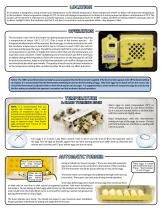
Catalog excerpts

The GEnesis Model 1588 Hova-Bator Unpack the incubator from box. Check for the components listed below. 1588 Top with heat element, fan, pilot light, thermostat, & vent plugs installed. SETUP over clips nder Slide oor & u er fl in wireplastic l Install the Plastic Liner and Wire Floor Hova-Bator Bottom Plastic Liner Wire Floor Power Supply Unpack the incubator from the box and set aside the power-supply, thermometer and wire floor. Remove the top half from the bottom. Attach Wire Floor to Plastic Liner with Owl Clips then place floor and liner in Hova-Bator Bottom. Arrange the plastic floor as shown using the water troughs and turner power cord notch as reference. Fill Center trough (highlighted) with warm water. Surface area, not depth, effects humidity; refill trough as necessary to prevent it from drying out. Place the top over the bottom. Plug the thin power cord into the receptacle located in the incubator’s top. Plug the cord set for the power supply into the appropriate wall socket. The fan should then run and the small red light on the thermostat box should be lit. Allow the incubator to warm up for one hour. When the light begins blinking regularly, the incubator is nearing its set point. The thermometer supplied maybe used to check the room temperature and to indicate when the incubator is nearing its operating temperature. Caution: The thermometer may not be as accurate as the thermostat and should not be trusted on the first couple of hatches.
Open the catalog to page 1
LOCATION An Incubator is designed to bring normal room temperature to the desired temperature. Room temperture of 60°F. or below will reduce the temperature in the incubator. Room temperature change of 10°F. or more will change temperature in incubator & is more pronounced below a temperature of 70°F. The location of the machine is important to successful operation. A room temperature from 70° to 80°F. is ideal, and fresh air without drafts is necessary. Be sure no direct sunlight strikes the incubator and that it sets level. A consistant room temperature within a few degrees is best....
Open the catalog to page 2
HATCHING USE CENTER TROUGH FOR SETTING BOTH TROUGHS FOR HATCHING Add water every few days to the center trough only. Usually twice a week is sufficient. The amount of moisture in the incubator is determined by the surface area of water exposed to the air. Under high humidity conditions and for some species of birds, less humidity is required. (The humidity in the incubator can be reduced by covering part of the water trough with aluminum foil and securing it with tape) Whenever there are doubts about the level of humidity in the incubator, less is usually better than more, except for the...
Open the catalog to page 3
POOR HATCH There are many factors involved with the hatching process and any one can hamper or stop chick development. Old eggs, infertile eggs, damaged or dirty eggs, poor flock health, and eggs not properly turned during incubation are some of the factors. Some chicks may only partially emerge from the shell. These chicks after time may be assisted out of the shell but due to their weak condition often do not survive. It is not unusual in a large batch of eggs to have a few of these even with good hatches. Check the unhatched eggs. Take note of the exact number of days it took to hatch...
Open the catalog to page 4All GQF Manufacturing Company catalogs and technical brochures
-
HOVA BATOR TM MODEL 2370
4 Pages
-
1602N THERMAL AIR
4 Pages
-
0248 TRIMMING INSTRUCTIONS
1 Pages
-
1200E SERIES INSTRUCTIONS
4 Pages
-
UNIVERSAL BOX BROODER
5 Pages
-
catalog
16 Pages











